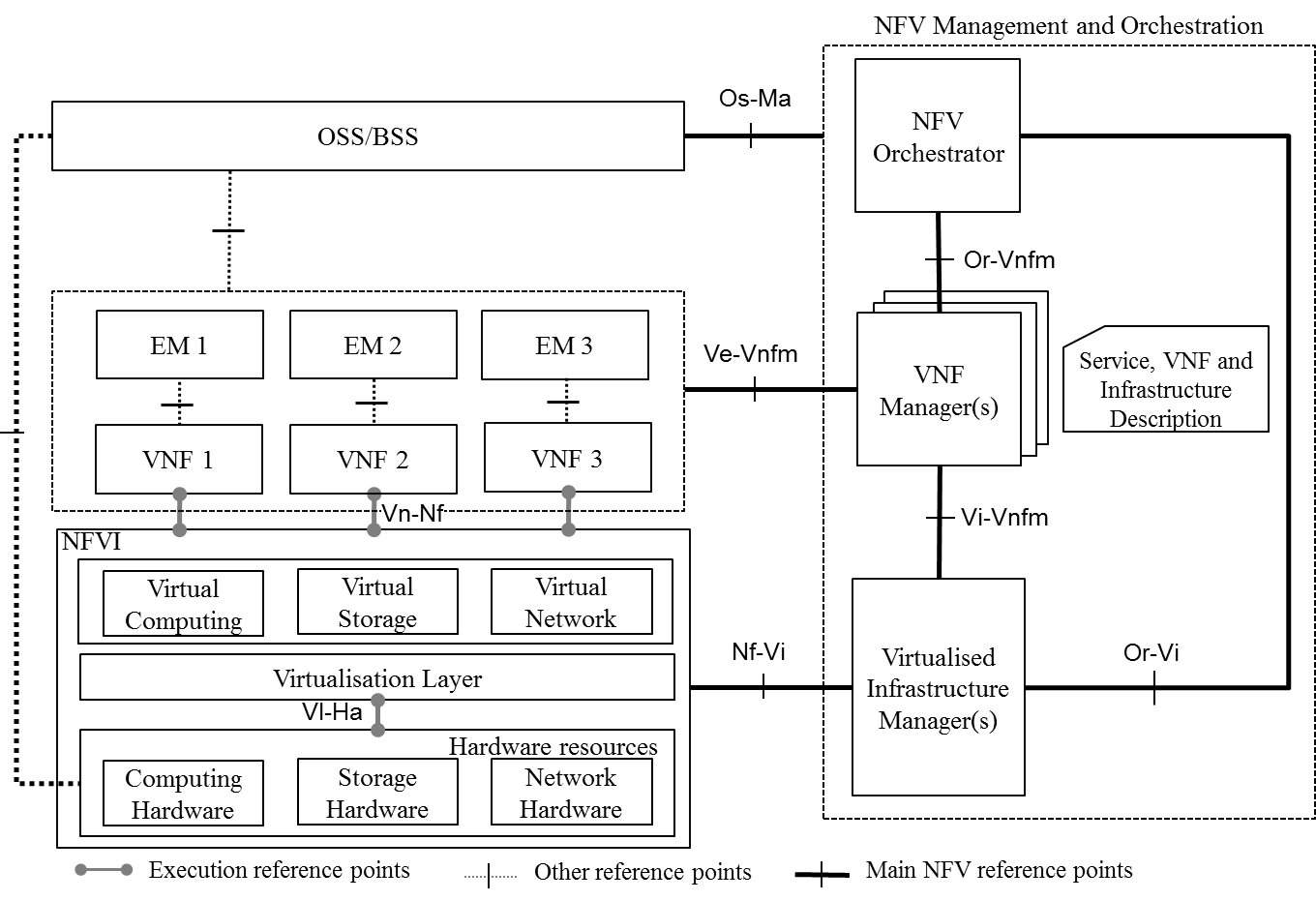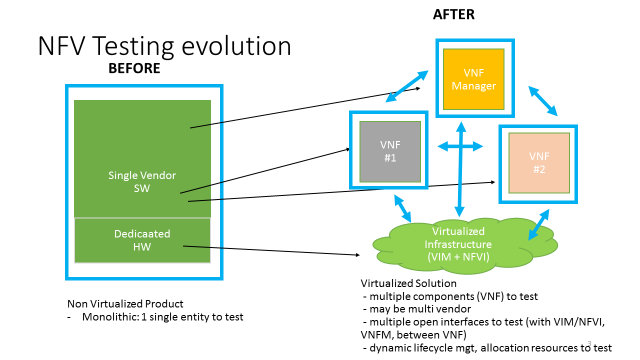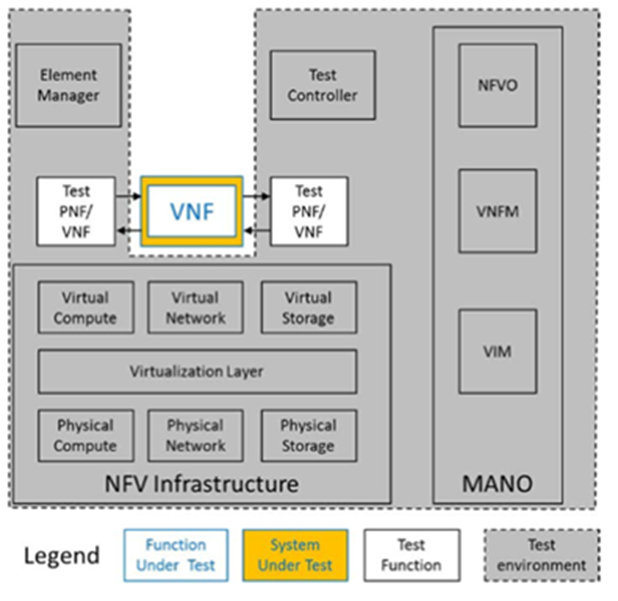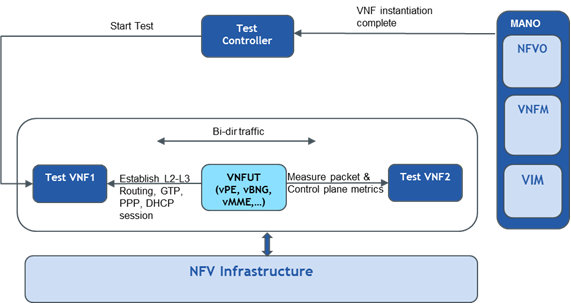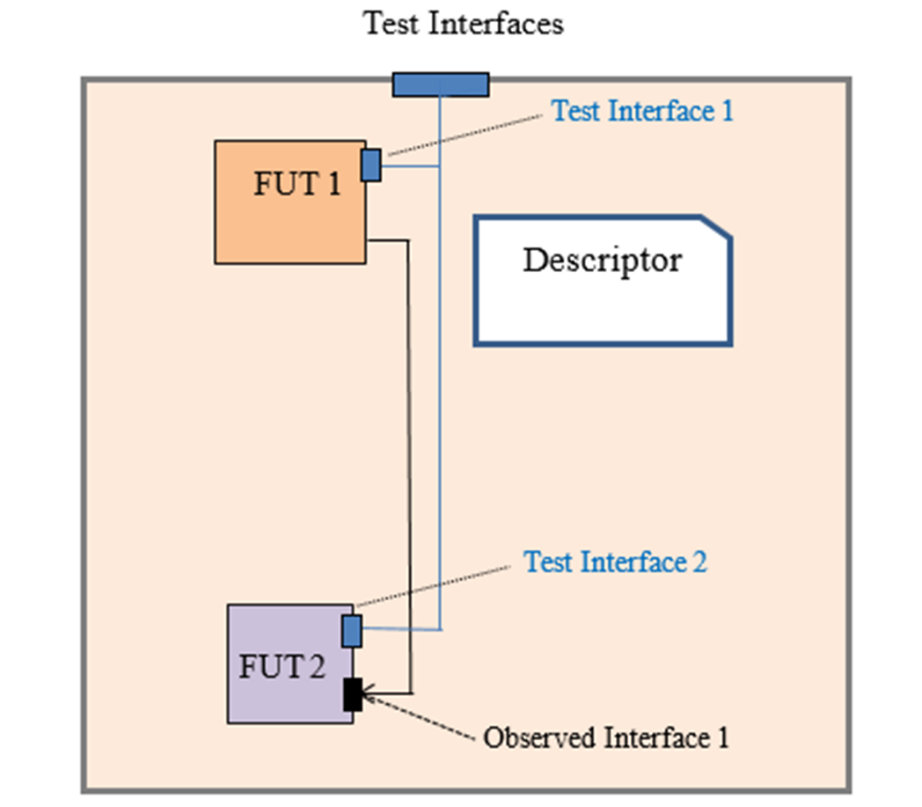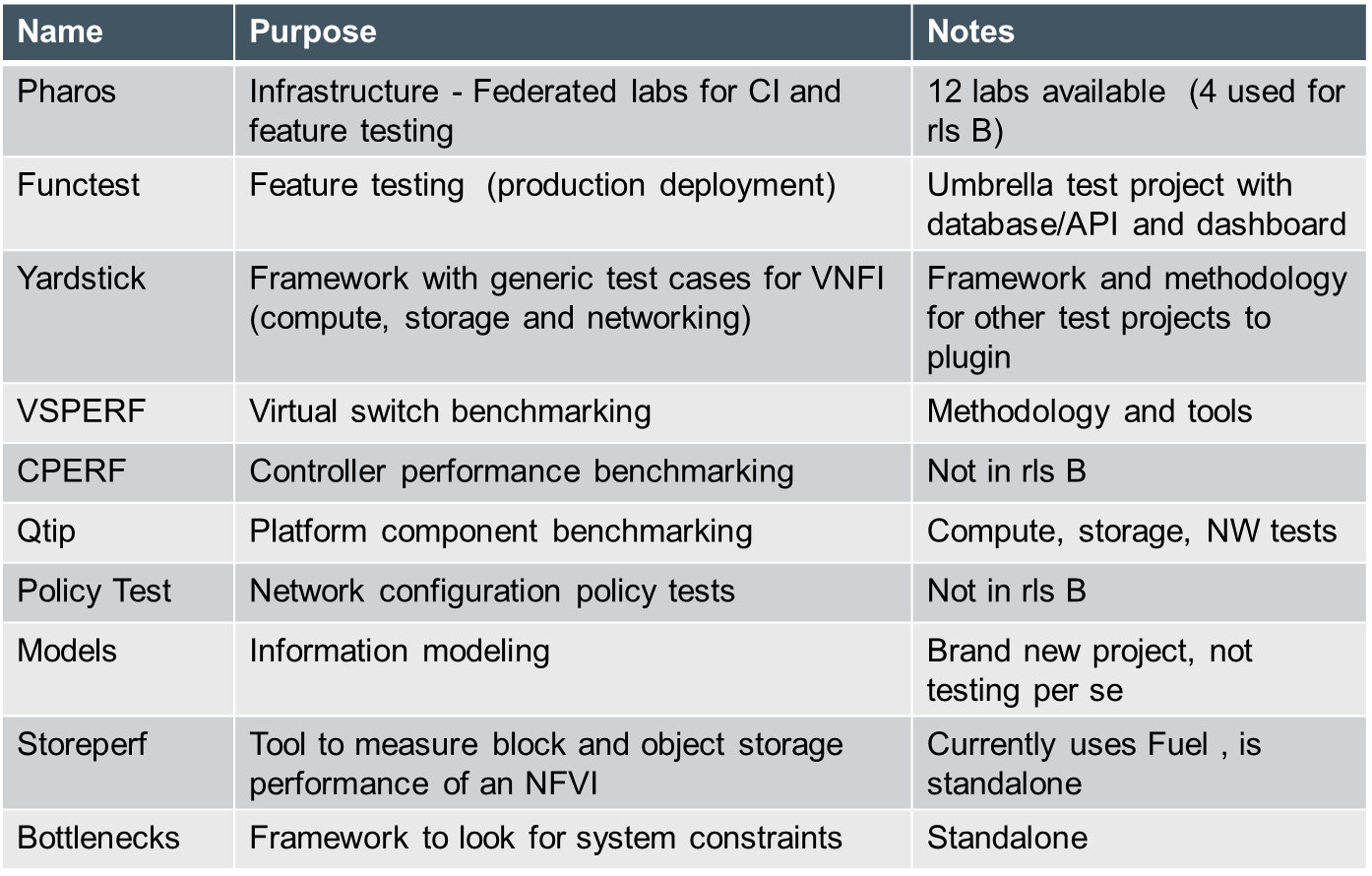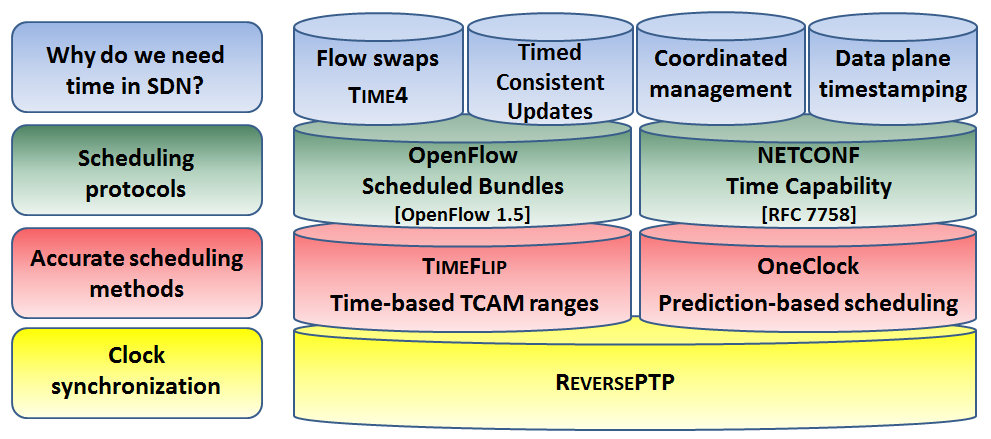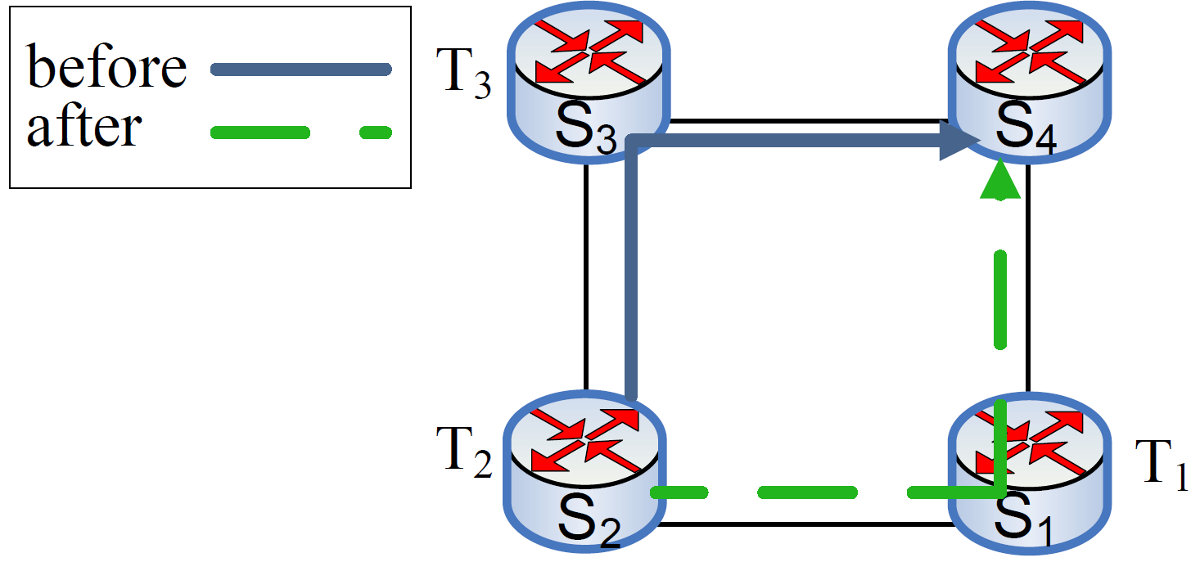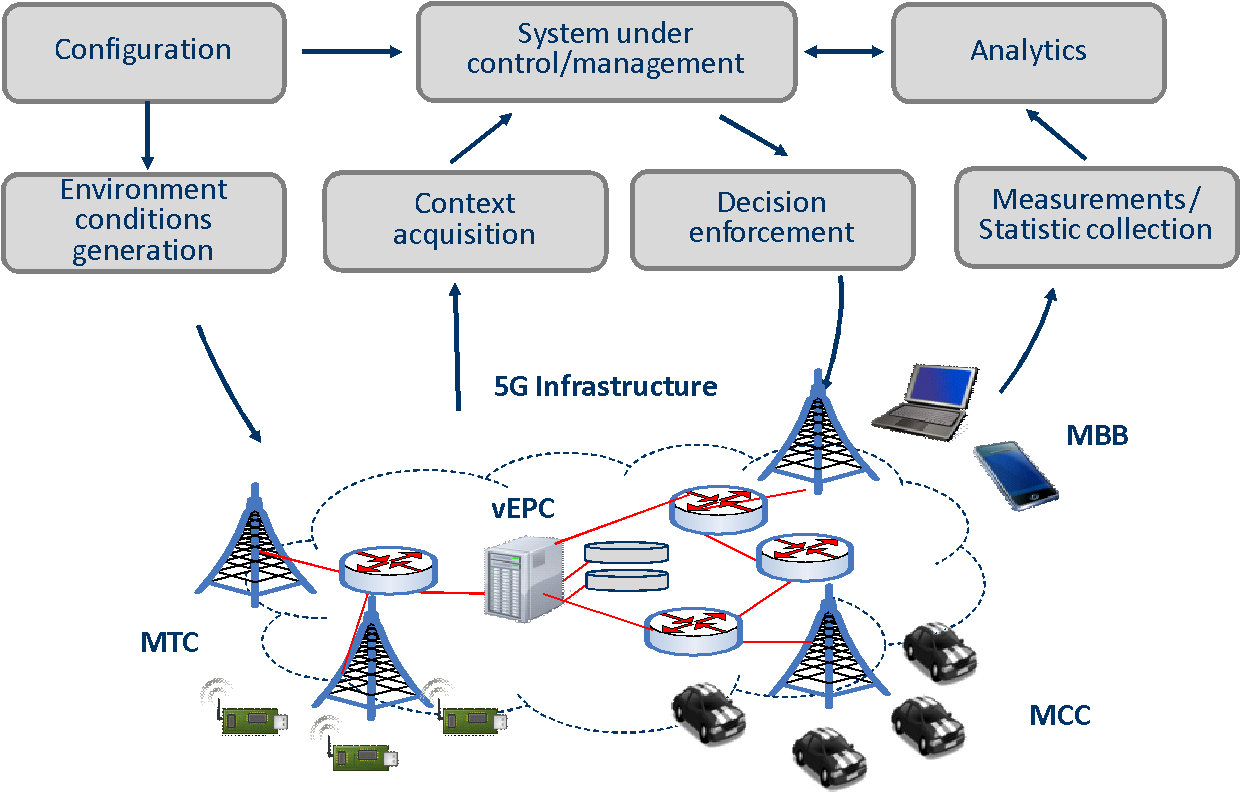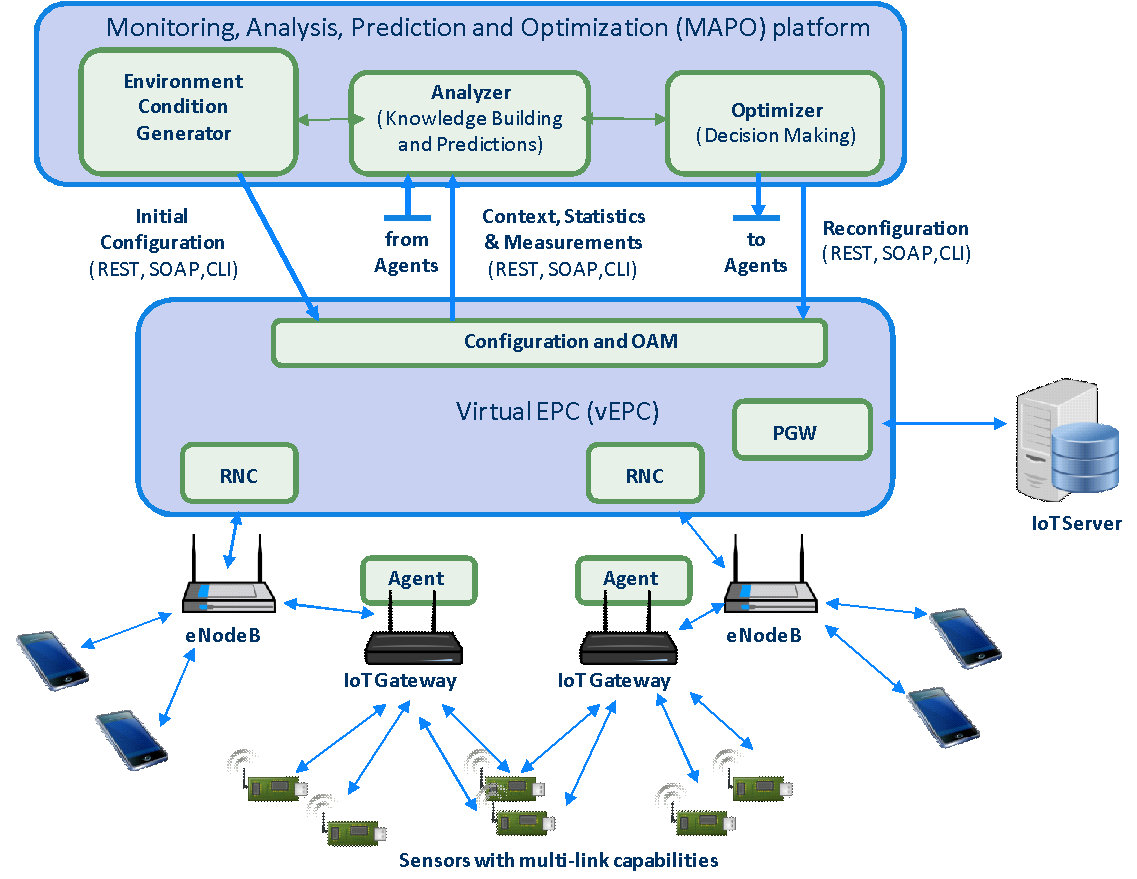NFV Testing
NFV Testing
Marie-Paule Odini, HPE
This article provides an overview of NFV Testing methodology and tools, covering work in standardization, in particular in ETSI NFV, and in Open Source with OPNFV.
The new challenges of NFV Testing
As network evolve towards NFV, the model of traditional monolithic network functions and single vendor solutions evolve to a set of virtualized functions from multiple vendors deployed on a virtualized infrastructure, with more and more dynamic and automatic lifecycle management. As such, traditional testing methodology and tools need also to evolve to cover the broader scope of configurations and live scenarios. Leveraging from different types of testing and methodologies as defined by ITU SG17 X.290 and ETSI EG 202 series such as:
- Pre-Validation Testing,
- Interoperability Testing,
- Conformance Testing,
- Performance Testing.
ETSI NFV has been working on few specifications specific to NFV Testing, so did IETF, but also OPNFV who has defined a number of tools to perform NFV Testing as part of the OPNFV Opensource project.
From testing monolithic product to testing NFV solution
ETSI NFV has defined the terminology and architectural framework of NFV environment with 3 key entities: virtualized infrastructure (NFVI) that replace the traditional dedicated hardware, Virtual Network Functions (VNF) and Management and Orchestration (MANO), itself composed of 3 components: a component to manage the infrastructure (VIM), a component to manage the virtualized functions (VNFM), and an orchestrator (NFVO), as defined in Fig 1.
Fig 1. ETSI NFV Architectural Framework – source ETSI NFV GS NFV 002
Testing is now evolving from testing monolithic products that include dedicated hardware and vendor software, to a solution where the hardware has moved to a virtualized infrastructure often provided by the Service Provider as a managed telco cloud, representing the ETSI NFV NFVI+VIM, and a set of virtualized functions called VNF by ETSI NFV, and a management function that manage the lifecycle of the VNF including dynamic scaling for instance, as depicted in Fig 2. All these components need to be separately tested, and interoperability between these components need also to be tested, as well as conformance of their interfaces to given standard or implementation, i.e. ETSI NFV or OpenStack for instance for the VIM. And performance testing need also to be performed in the design phase to provide infrastructure and resource requirements, but also after deployment to validate that the allocation of resources meets the requirements and the VNF delivers the expected performance.
Fig 2. Evolution from monolithic product testing to NFV solution testing
Pre-validation testing
ETSI NFV has published a specification on pre-validation testing that provides guidelines to perform testing of an NFV environment, including testing of the NFVI, NFVI+VIM, MANO and VNF, see ETSI NFV TST001 for more details.
Typically for VNF testing, an NFV Testing environment needs to be defined, with a set of reference components that support the VNF: NFVI+MANO, a Test controller that will control the test execution and collect results, and test PNF/VNF that will inject traffic to the VNF Under Test (VNFUT). Then the VNFUT needs to be characterized, whether it is a data plane function or a control plane function, the VNF Package needs to be collected and validated, then the testing of the VNF Lifecycle Management can proceed as described in clause 7 of ETSI NFV TST001. Testing needs to be performed for VNF onboarding, instantiation, scaling and termination. Test scripts are defined, metrics are defined and test can be performed with the Test Controller and the test PNF/VNF interacting with the NFV environment and the VNFUT.
Fig 3. VNF Under Test (VNFUT) in an NFV testing environment
For instance for a Data Plane VNF, covering L2-L3, once VNF onboarding and VNF Instantiation have been performed, Validation of the Instantiation of the VNF is triggered by a Test initiated by the Test Controller asking a Test PNF1 or VNF1 to inject traffic in the VNFUT. A second test PNF2 or VNF2 then measure the packets and pre-defined metrics.
Fig 4. Validation the Instantiation of a L2-L3 VNFUT - source ETSI NFV TST001
Some ongoing work is currently being completed on VNF Package with some guidelines on VNF Package testing in ETSI NFV IFA011.
Interoperability Testing
As VNF interact with many other elements in the NFV environment, NFVI, VNF Manager, other VNF, performing interoperability testing prior to deployment is also important, especially since different combinations are possible and environments may change dynamically during the course of life of a given VNF. ETSI NFV has defined methodology for NFV Interop test in ETSI NFV GS TST002 which is about to be published. Interoperability testing is testing the functional level, not the protocol. Entities in the test environment access the different Functions Under Test (FUT) via the Test Interfaces offered by the SUT. An SUT is typically composed of one or more FUT. In the case of Interop testing, it is a minimum of 2 FUTs that interop with each other. When the FUT is a VNF, the term VNFUT is used. In the example below in Fig 4, Interop test are performed between FUT1 and FUT2. The “observed interface 1” which connects FUT1 and FUT2 is tested via a set of test scripts that will exercise the SUT Test Interfaces that is sending traffic to FUT1 Test Interface for instance and collecting results on FUT2 Test Interface.
Fig 4. NFV Interop test example
ETSI NFV TST002 has defined a set of guidelines including the list of NFV Interoperability Features Statement (IFS) to test, according to ETSI NFV standard. This includes VNF Package Management, VNF SW Image Management , NS Descriptor Management , VNF Lifecycle Management , VNF Fault, Configuration and Performance Management , NS Lifecycle Management , NS Fault and Performance Management. The structure of a typical interoperability test description is providing an Identifier, test purpose, configuration, pre-condition, test sequence, IoP verdict etc – and then for each feature, details of the SUT configuration, the observed interface and the test interfaces are detailed. A few examples are also provided such as VNF onboarding with the call flow and the test description. ETSI NFV TST007 is now defining the Test Suite for these interoperability tests, current work has started for VIM-VNFM interoperability based on the following standard IFS defined in IFA006 on Vi-Vnfm: Software Image Management, Lifecycle Management, Network Resource Management, Fault and Performance Management. For each, the IFS is described, the Test Case Overview, and the Test Description. Test Suite will be provided in the annex and will be in line with the ETSI NFV PlugTest test plan. These test suites will be actual tests that the industry can use to perform interop test between 2 NFV entities as defined by ETSI NFV.
ETSI is organizing an ETSI NFV Plugtest early 2017. Vendors and participants will come with their NFV components (VNF, NFVI-VIM or VNFM-NFVO) to perform live interop tests as defined by ETSI based on ETSI NFV TST007 specifications. More details are available on www.etsi.org/nfvplugtest
Further work on NFV Testing
Besides the work detailed above, ETSI NFV has also published specification for performance testing guidelines with ETSI NFV Performance and Portability Guidelines, ETSI GS NFV-PER 001, and Service Quality Metrics, ETSI GS NFV-INF 010. Some work is also under way for Path testing, ETSI NFV TST004.
OPNFV OpenSource Project has also produced a number of tools for functional testing, vswitch performance testing and different solutions as part of the OPNFV CI/CD environment and used in OPNFV Pharos labs. This code is freely available under the OPNFV OpenSource project.
A few other standards have also produced some work that can be leveraged for NFV Testing, such as:
- IETF/IRTF NFV Benchmarking draft (draft-huang-bmwg-virtual-network-performance-01: “Benchmarking methodology for Virtualization Network Performance”),
- IETF devops draft (https://tools.ietf.org/html/draft-sonata-nfvrg-devops-gatekeeper-00 : “The Role of a Mediation Element in NFV DevOps”) or
- IETF SDN controller benchmarking drafts (https://tools.ietf.org/html/draft-ietf-bmwg-sdn-controller-benchmark-meth-02 : “Benchmarking Methodology for SDN Controller Performance“.
More on NFV Training with ETSI NFV Tutorial available on: http://www.layer123.com/nfv-webcast-mle123/
 Marie-Paule Odini holds a master's degree in electrical engineering from Utah State University. Her experience in telecom experience including voice and data. After managing the HP worldwide VoIP program, HP wireless LAN program and HP Service Delivery program, she is now HP CMS CTO for EMEA and also a Distinguished Technologist, NFV, SDN at Hewlett-Packard. Since joining HP in 1987, Odini has held positions in technical consulting, sales development and marketing within different HP organizations in France and the U.S. All of her roles have focused on networking or the service provider business, either in solutions for the network infrastructure or for the operation.
Marie-Paule Odini holds a master's degree in electrical engineering from Utah State University. Her experience in telecom experience including voice and data. After managing the HP worldwide VoIP program, HP wireless LAN program and HP Service Delivery program, she is now HP CMS CTO for EMEA and also a Distinguished Technologist, NFV, SDN at Hewlett-Packard. Since joining HP in 1987, Odini has held positions in technical consulting, sales development and marketing within different HP organizations in France and the U.S. All of her roles have focused on networking or the service provider business, either in solutions for the network infrastructure or for the operation.
Editor:
 Laurent Ciavaglia is currently senior research manager at Nokia Bell Labs where he coordinates a team specialized in autonomic and distributed systems management, inventing future network management solutions based on artificial intelligence.
Laurent Ciavaglia is currently senior research manager at Nokia Bell Labs where he coordinates a team specialized in autonomic and distributed systems management, inventing future network management solutions based on artificial intelligence.
In recent years, Laurent led the European research project UNIVERSELF (www.univerself-project.eu) developing a unified management framework for autonomic network functions. , has worked on the design, specification and evaluation of carrier-grade networks including several European research projects dealing with network control and management.
As part of his activities in standardization, Laurent participates in several working groups of the IETF OPS area and is co-chair of the Network Management Research Group (NRMG) of the IRTF, member of the Internet Research Steering Group (IRSG). Previously, Laurent was also vice-chair of the ETSI Industry Specification Group on Autonomics for Future Internet (AFI), working on the definition of standards for self-managing networks.
Laurent has co-authored more than 80 publications and holds 35 patents in the field of communication systems. Laurent also acts as member of the technical committee of several IEEE, ACM and IFIP conferences and workshops, and as reviewers of referenced international journals, and magazines.
The TimedSDN Project
The TimedSDN Project
Tal Mizrahi and Yoram Moses, Technion - Israel Institute of Technology
Abstract. The TimedSDN project explores the use of time and synchronized clocks in Software Defined Networks (SDNs). One of the main goals of this project is to analyze use cases in which using time is beneficial. Both theoretical and practical aspects of timed coordination and synchronized clocks in SDN are analyzed in this work. Some of the products of this work are already incorporated in the OpenFlow specification, and open source prototypes of the main components are publicly available.
Introduction
Network time synchronization has evolved significantly over the last decade. Indeed, the Precision Time Protocol (PTP), defined in the IEEE 1588 standard, can synchronize clocks to a very high degree of accuracy, typically on the order of 1 microsecond. Since its publication in 2008, PTP has matured and has become a common and affordable feature in commodity switches. We argue that since most of the SDN products already have built-in hardware capabilities for accurate clock synchronization, it is only natural to harness this powerful technology to coordinate events in SDNs.
The key concept behind the TimedSDN project is simple: accurate time can be used to coordinate network configuration and policy updates in SDNs. In a nutshell, the SDN controller can invoke time-triggered updates in network switches, allowing near-simultaneous network-wide updates, or allowing the controller to invoke multi-step updates, in which each step is invoked at a different update time.
Four main aspects of time in SDN are analyzed in this project, depicted in the four rows of Fig. 1.
Figure 1. The TimedSDN project at a glance.
Why do we need time in SDN?
We briefly present a few key use cases that greatly benefit from using time.
Flow swaps. Time4 is a network update approach that we introduced in [1,2]. In this approach multiple changes are performed at different switches at the same time.
The work of [1,2] considers a class of network update scenarios called flow swaps, and shows that Time4 is the optimal approach for implementing them; Time4 allows fewer packet drops and higher scalability than state-of-the-art approaches. A flow swapping example is presented in Fig. 2.
In this work we presented the lossless flow allocation (LFA) problem, and used a game-theoretic analysis to formally show that flow swaps are inevitable in the dynamic nature of SDN.
Figure 2. Flow swapping: flows need to convert from the `before' configuration to the `after' configuration. Updating S1 and S2 at the same time is the optimal approach.
Timed consistent updates. A consistent network update [3] is an update that guarantees that every packet is forwarded either according to the previous configuration before the update, or according to the new configuration after the update, but not according to a mixture of the two.
The approach we presented in [4,5] introduces time-triggered multi-phase network updates, which can guarantee consistency while requiring a shorter duration than existing consistent update methods. An example is depicted in Fig. 3.
This approach is shown to reduce the expensive overhead of maintaining duplicate configurations.
Figure 3. A timed consistent update example: when updating from the `before' to the `after' configuration, each local update is performed at a different time, T1, T2, and T3.
Data plane timestamping. In [6] we argued that in the unique environment of SDN, attaching a timestamp to the header of all packets is a powerful feature that can be leveraged by various diverse SDN applications. We analyzed three key use cases that demonstrate the advantages of using DPT: (i) network telemetry, (ii) consistent network updates, and (iii) load balancing. We also showed that SDN applications can benefit even from using as little as one bit for the timestamp field.
Coordinated management. As discussed in [7], time can be a valuable tool in coordinating network management, not only in SDNs, but in any centrally managed network. For example, synchronized time can be used to coordinate a configuration update that should be performed at multiple nodes at the same time, or to take a coordinated snapshot of the state of multiple nodes in the network.
Scheduling protocols
One of the main goals of this project is to define extensions to standard network protocols, enabling practical implementations of the concepts we present. We defined a new feature in OpenFlow called Scheduled Bundles [1,2], and a similar capability in NETCONF [7]. These two features enable time-triggered operations in OpenFlow and in NETCONF, respectively. As a result of our work, the capability to perform time-triggered updates has been incorporated into the OpenFlow 1.5 protocol [8], and has been defined for the NETCONF protocol in an experimental IETF RFC [9]. Open source prototypes are available for these extensions [10].
Accurate scheduling methods
One of the main challenges in the use of accurate time is to implement accurate execution of events, i.e., guaranteeing that scheduled network updates are executed as close as possible to the time for which they were scheduled. Even if all the switches have perfectly synchronized clocks, executing events at their scheduled time may be challenging due to the nondeterministic nature of the switches' operating systems, and due to other running tasks. Two accurate scheduling methods were defined and analyzed in this project, TimeFlip and OneClock.
TimeFlip. In [11,12] we introduced TimeFlips, which can be implemented in Ternary Content Addressable Memories (TCAM). A TimeFlip is a timestamp-based TCAM range in a hardware switch. We showed that TimeFlip is a practical method of implementing accurate time-based network updates using time-based TCAM ranges. TimeFlip was tested in practice on a real-life device, a Marvell DX switch, showing that a TimeFlip can be performed with a sub-microsecond accuracy, requiring very limited TCAM memory resources.
OneClock. OneClock [7] is a prediction-based scheduling approach that uses timing information collected at runtime to accurately schedule future operations. Three prediction algorithms were analyzed in this work: (i) an average-based algorithm, (ii) a fault-tolerant average (FT-Average), and (iii) a Kalman-Filter-based algorithm.
Clock synchronization
Clock synchronization is an essential piece in the puzzle. ReversePTP [13,14,15] is a clock synchronization scheme that is adapted to the centralized SDN environment; in ReversePTP all nodes (switches) in the network distribute timing information to a single software-based central node (the SDN controller), that tracks the state of all the clocks in the network (see Fig. 4). Thus, all computations and bookkeeping are performed by the central node, whereas the `dumb' switches are only required to periodically send their current time to the controller. In accordance with the SDN paradigm, the `brain' is implemented in software, making ReversePTP flexible and programmable from an SDN programmer's perspective.
Interestingly, ReversePTP can be defined as a PTP profile, i.e., a subset of the features of PTP. Consequently, ReversePTP can be implemented by existing PTP-enabled switches.
Figure 4. ReversePTP in SDN: switches distribute their time to the controller. Switches' clocks are not synchronized. For every switch i, the controller knows offseti, the offset between switch i's clock and its local clock.
Conclusion
The TimedSDN project studies various aspects of using synchronized time in SDN. We believe there is great potential for future work, as many SDN applications may benefit from using time and synchronized clocks.
References
[1] T. Mizrahi and Y. Moses, “Software Defined Networks: It’s about time,” in IEEE INFOCOM, 2016.
[2] T. Mizrahi and Y. Moses, “Time4: Time for SDN,” IEEE Transactions on Network and Service Management (TNSM), 2016.
[3] M. Reitblatt, N. Foster, J. Rexford, C. Schlesinger, and D. Walker, “Abstractions for network update,” in ACM SIGCOMM, 2012.
[4] T. Mizrahi, E. Saat, and Y. Moses, “Timed consistent network updates,” in ACM SIGCOMM Symposium on SDN Research (SOSR), 2015.
[5] T. Mizrahi, E. Saat, and Y. Moses, “Timed consistent network updates in software defined networks,” IEEE/ACM Transactions on Networking (ToN), 2016.
[6] T. Mizrahi and Y. Moses, “The case for data plane timestamping in sdn,” in IEEE INFOCOM Workshop on Software-Driven Flexible and Agile Networking (SWFAN), 2016.
[7] T. Mizrahi and Y. Moses, “OneClock to rule them all: Using time in networked applications,” in IEEE/IFIP Network Operations and Management Symposium (NOMS) mini-conference, 2016.
[8] Open Networking Foundation, “Openflow switch specification,” Version 1.5.0, 2015.
[9] T. Mizrahi and Y. Moses, “Time Capability in NETCONF,” RFC 7758, IETF, 2016.
[10] “TIME4 source code,” https://github.com/TimedSDN, 2014.
[11] T. Mizrahi, O. Rottenstreich, and Y. Moses, “TimeFlip: Scheduling network updates with timestamp-based TCAM ranges,” in IEEE INFOCOM, 2015.
[12] T. Mizrahi, O. Rottenstreich, and Y. Moses, “TimeFlip: Using Timestamp-based TCAM Ranges to Accurately Schedule Network Updates,” IEEE/ACM Transactions on Networking (ToN), 2016.
[13] T. Mizrahi and Y. Moses, “Using ReversePTP to distribute time in software defined networks,” in International IEEE Symposium on Precision Clock Synchronization for Measurement Control and Communication (ISPCS), 2014.
[14] T. Mizrahi and Y. Moses, “ReversePTP: A software defined networking approach to clock synchronization,” in ACM SIGCOMM Workshop on Hot topics in Software Defined Networks (HotSDN), 2014.
[15] T. Mizrahi and Y. Moses, “ReversePTP: A clock synchronization scheme for software defined networks,” International Journal of Network Management (IJNM), 2016.
 Tal Mizrahi is a switch architect at Marvell, with over 15 years of experience in networking. He has recently completed his PhD at the Technion. Tal is an active participant in the Internet Engineering Task Force (IETF), and in the IEEE 1588 working group. His fields of interest include network protocols, switch and router architecture, time synchronization, and distributed systems.
Tal Mizrahi is a switch architect at Marvell, with over 15 years of experience in networking. He has recently completed his PhD at the Technion. Tal is an active participant in the Internet Engineering Task Force (IETF), and in the IEEE 1588 working group. His fields of interest include network protocols, switch and router architecture, time synchronization, and distributed systems.
 Yoram Moses is the Israel Pollak academic chair and a professor of electrical engineering at the Technion. His research focuses on distributed and multi-agent systems, with a focus on fault-tolerance and on applications of knowledge and time in such systems. He is a co-author of the book Reasoning about Knowledge, recipient of the Gödel prize in 1997 and the Dijkstra prize in 2009.
Yoram Moses is the Israel Pollak academic chair and a professor of electrical engineering at the Technion. His research focuses on distributed and multi-agent systems, with a focus on fault-tolerance and on applications of knowledge and time in such systems. He is a co-author of the book Reasoning about Knowledge, recipient of the Gödel prize in 1997 and the Dijkstra prize in 2009.
Editor:
 Eliezer Dekel is a Chief Architect for Huawei Technologies Corporate Reliability Department. He is researching RAS for SDN and NFV. He retired from IBM Research - Haifa, as a Senior Technical Staff Member and Chief Architect for Distributed Systems. In his this role he focused on developing infrastructure technologies for very large scale distributed systems.
Eliezer Dekel is a Chief Architect for Huawei Technologies Corporate Reliability Department. He is researching RAS for SDN and NFV. He retired from IBM Research - Haifa, as a Senior Technical Staff Member and Chief Architect for Distributed Systems. In his this role he focused on developing infrastructure technologies for very large scale distributed systems.
Eliezer Dekel is the editor in chief of EAI Endorsed Transaction on Cloud Systems. He is also an Associate Editor for ACM Computing Surveys and a member of the editorial board for IEEE SDN Newsletter. Eliezer served on numerous conference program committees and organized, or served as chair in some of them. He has been involved in research in the areas of distributed and fault-tolerant computing, service-oriented technology, and software engineering. He was recently working on technologies for providing Quality of Service, with a focus on dependability, in very large scale multi-tier environments. For this area he initiated together with colleagues the very successful International Workshop on Large Scale Distributed Systems and Middleware (LADIS). This workshop, sponsored by ACM. It was one of the first workshops to focus on the foundations of "cloud computing." He was an organizer of CloudSlam'09 the first cloud computing virtual conference. Eliezer was also involved in several EU FP7 ICT funded projects.
Eliezer has a Ph.D. and M.Sc. in computer science from the University of Minnesota, and a B.Sc. in mathematics from Ben Gurion University, Israel. Prior to joining IBM Research - Haifa, Eliezer served on the faculty of the University of Texas at Dallas computer science department for more than ten years.
Proactive Management of the Virtualized Mobile Core for IoT
Proactive Management of the Virtualized Mobile Core for IoT
Evangelos Kosmatos, Kostas Tsagkaris, Incelligent, Athens, Greece; Panagiotis Demestichas, University of Piraeus, Dpt of Digital Systems, School of ICT, Piraeus, Greece; and Christos Kolias, Orange Silicon Valley, San Francisco, United States
Introduction and Motivation
Machine to machine (M2M) communications enable the Internet of Things where billions of devices, typically low power devices requiring low data rates, work with little or no human intervention. The convergence of cellular and Low Power Wide Area networks (LPWANs) under the umbrella of 5G is expected to connect a new generation of such M2M devices. However, the majority of current wireless systems, including LTE/LTE-A, are currently designed and optimized to support mainly Mobile BroadBand (MBB) services and so not ideally suited for the M2M communication scenarios.
The characteristics of IoT network environments (e.g. LPWANs) are drastically different from that of legacy MBB environment. MBB environments are characterized by small number of user devices with high bandwidth requirements due to the proliferation of bandwidth consuming services (e.g. streaming services) moving potentially with high speeds (high mobility). On the contrary, IoT environments, supporting Machine Type Communications (MTC) and Mission Critical Communications (MCC) services, are characterized by high or even massive number of devices transmitting sporadic small messages (reports) with low bandwidth requirements and with mobility characteristics depending on the vertical services to be supported, e.g. no mobility in agricultural scenarios, high mobility in Vehicle-to-Everything (V2X) scenarios. MTC services are characterized mainly by high connection density requirements with relaxed latency and reliability requirements, while MCC require ultra low end-to-end latency and ultra reliable connectivity [1].
Due to the aforementioned heterogeneous characteristics a "one-size-fits-all" network configuration solution, as envisaged in LTE/LTE-A, is not practical. In addition, LPWANs are very heterogeneous environments, supporting lots of end-devices for different applications with different requirements using the same IoT infrastructure, but they lack of advanced/developed management and orchestration tools.
Platform for the Proactive Management of Virtualized Mobile Core for IoT
In order to alleviate the aforementioned inefficiencies, a number of steps should be taken in order both core and access networks to become more agile, in their ability to dynamically instantiate new services, allocate resources on-demand and pre-allocate resources. This agility should be accompanied with the appropriate tools to exploit it and provide configuration solutions which are fine tuned to the temporal and spatial network needs and require minimum human intervention. In this direction, the virtualization in core network, e.g. the deployment of a virtual EPC (vEPC) ([3], [4]) instead of a legacy one, is the main driver for increasing this kind of agility, since in the virtualized case the total EPC resources can be arbitrarily allocated among the EPC modules. EPC virtualization is a relevant example of NFV that has attracted a lot of attention from industry ([4],[5]). LPWANs are very heterogeneous and complex environments which lacks of advanced management tools, while the recent emergence of multi-link functionalities which support alternative transmission paths and improve availability and reliability, increase further this complexity. Therefore the development of advanced management and orchestration tools is of high importance. These solutions can be further enhanced by efficient SDN/NFV architectures e.g. the ARCADIA framework [2], which extend this flexibility in the software development, deployment, and execution phases.
The aforementioned configuration possibilities will have significant impact on IoT networks if they can be realized: a) in a spatial and temporal manner (e.g. the IoT traffic volume may vary from cell to cell and from time to time); b) in a highly automatic manner with minimum human intervention; c) can be enhanced with prediction capabilities in order to support proactive control and management. In this direction, an analysis for prediction and proactive management framework is proposed, illustrated in Fig.1. In order to deliver value, the framework relies on a continuous loop that iterates among collecting data from the 5G, analyzing data for learning patterns, predicting future conditions, producing and enforcing management actions and finally learning the efficiency of the management actions by obtaining feedback from the infrastructure.
Fig. 1: Analysis, knowledge building, prediction and management framework
Proof of Concept
The proposed platform can be implemented as a Proof of Concept (PoC) by integrating the monitoring, analysis, prediction and optimization platform with a 5G network infrastructure, as illustrated in Fig. 2. The 5G infrastructure can be comprised of a virtual EPC, the cellular access nodes (e.g. eNodeBs) and the available LPWANs (e.g. based on LoRa [6] or Sigfox [7] technologies). On the other end of the network is the IoT Server which handles IoT reports generated by the sensors. The initialization, configuration and reconfiguration of vEPC VNFs (e.g. PCRF, HSS, MME), can be realized through the communication with the northbound interface of vEPC, while agents should be implemented and placed in the IoT gateways in order to enable the communication with the LPWANs. The communication in northbound interface can be realized using alternative solutions, like REST which is a more lightweight protocol, SOAP protocol or a simple CLI interface. The basic building blocks of the proactive management platform are the Environment Condition Generator, the Analyzer and the Optimizer. The Environment Condition Generator is responsible for the initial network planning and deployment of initial configuration actions. The Analyzer collects measurements and statistics from the network and builds knowledge which is delivered to Optimizer. The main responsibilities of Optimizer are the decision making process based on current network conditions and predictions on future network conditions and the enforcement of configuration actions to the network elements. The latter is realized through the northbound interface of vEPC and the deployed IoT agents.
Fig. 2: PoC architecture
Research Challenges and Expected Gains
As with all new architectural approaches, the aforementioned possibilities come with their own challenges. Regarding research challenges one interesting aspect is the efficiency of the proposed platform to predict significant changes on the 5G infrastructure which require the reconfiguration of the vEPC and/or the IoT gateways. Significant changes may include for example a notable change of MBB/MTC/MCC service mix, or a significant change in the traffic volume and mix in a spatial or temporal manner. The aforementioned efficiency can be expressed by the ability to predict significant changes in a fast and reliable manner. This is a significant gain compared to the current reactive platforms (reacting to a second or even minute scales), since it will minimize the time (down to ms) between the actual change and the reaction to this change. In terms of performance indicators it can be measured by the prediction accuracy and the before-after performance gains of the network.
Another important challenge is the optimal capture and processing of IoT data. In a LPWAN most of the data produced in the network may not be useful to any user. Therefore in order to minimize the huge traffic entering the core network (600K devices per Km2 are expected to be connected in the near future [8]) to only the useful one, the configuration of the IoT gateways should include rules for data filtering and possibly processing. In terms of gains, an efficient filtering may significantly decrease the volume of IoT traffic traversing the 5G core network.
In addition, a major challenge is the satisfaction of the strict requirements imposed by the emerging MCC services, namely ultra low latency (below 1ms [8]) and ultra reliable connectivity (at least 99.999% [8]). In this direction, the level of convergence between the vEPC and the LPWANs in terms of cross-technology optimization and end-to-end QoS/QoE support, will affect the latency related KPIs, while the exploitation of the multi-link capabilities of sensors can increase the reliability and availability KPIs.
Finally, a challenge which is of vital importance for the stakeholders (e.g. network operators) is the minimization of human intervention. The objective of the proposed platform is the automatic configuration/reconfiguration of the vEPC and IoT networks based on current statistics and predictions based on stored knowledge. The adoption of a close loop proactive management platform (like the one proposed) with strong predictive capabilities based on machine learning techniques will dramatically decrease the human intervention to only minimal tasks like the definition of the system targets.
References
[1] NGMN Alliance, “NGMN 5G White Paper” - v1.0, 17th February, 2015[2] ARCADIA Project, Website: http://www.arcadia-framework.eu/wp/
[3] Hawilo, A. Shami, M. Mirahmadi, and R. Asal, “NFV: State of the Art, Challenges and Implementation in Next Generation Mobile Networks (vEPC)", Network, IEEE 28 (6), 18-26
[4] Mijumbi, J. Serrat, J. Gorricho, N. Bouten, F. De Turck, and R. Boutaba, “Network function virtualization: State-of-the-art and research challenges,” IEEE Communications Surveys & Tutorials, 2015.
[5] Manzalini et. al., "Towards 5G Software-Defined Ecosystems", IEEE SDN White paper, June 2014
[6] LoRa Alliance, Website: https://www.lora-alliance.org/
[7] Sigfox, Website: https://www.sigfox.com/
[8] 5G-PPP Project FANTASTIC-5G, Deliverable D2.1 "Air interface framework and specification of system level simulations", May 2016
 Dr. Evangelos Kosmatos received his Dipl-Ing. degree and his Ph.D. Degree from the school of Electrical and Computer Engineering (ICCS) of National Technical University of Athens (NTUA), Greece, in 2002 and 2008 respectively. He has participated in several EU projects (IST AQUILA, ENAMORADO, SMS, INCASA, STRONGEST, IDEALIST, FANTASTIC-5G, SPEED-5G) as well as national projects (CONFES, WisePON). His research interests include 4G, 5G networks, optical networks (EPON, GPON, WDM-PON), network control plane design, Radio-over-Fiber (RoF) networks, protocols and algorithms supporting Quality of Service in heterogeneous networks, sensors / actuators networks (Internet of Things), middleware and distributed technologies; he has 10 publications in international journals and 20 publications in international conferences related to these fields.
Dr. Evangelos Kosmatos received his Dipl-Ing. degree and his Ph.D. Degree from the school of Electrical and Computer Engineering (ICCS) of National Technical University of Athens (NTUA), Greece, in 2002 and 2008 respectively. He has participated in several EU projects (IST AQUILA, ENAMORADO, SMS, INCASA, STRONGEST, IDEALIST, FANTASTIC-5G, SPEED-5G) as well as national projects (CONFES, WisePON). His research interests include 4G, 5G networks, optical networks (EPON, GPON, WDM-PON), network control plane design, Radio-over-Fiber (RoF) networks, protocols and algorithms supporting Quality of Service in heterogeneous networks, sensors / actuators networks (Internet of Things), middleware and distributed technologies; he has 10 publications in international journals and 20 publications in international conferences related to these fields.
 Dr. Kostas Tsagkaris is Managing Director and Head of Technology of Incelligent. He holds a bachelor and PhD degree (“Ericsson’s awards of excellence in Telecommunications”) from the School of Electrical Engineering and Computer Science of the National Technical University of Athens (NTUA). Since 2005 he is working as a senior research engineer and adjunct Lecturer in the undergraduate and postgraduate programs at the Department of Digital Systems of the University of Piraeus. In 2012 he co-founded WINGS ICT Solutions, an SME conducting research and development in 5G wireless access systems, device management, software networks and IoT. In 2014 he also co-founded Incelligent, a spin-out of WINGS ICT Solutions producing software for the predictive management and optimization of telecom operations. He has been involved in many international research projects and bilateral collaborations with the telecom industry, especially working in the areas of design, management and optimization of wireless access/core networks, self-organizing and autonomic networks, network virtualization and softwareization and software engineering. He has published more than 160 papers in international journals and refereed conferences in the areas above. Dr. Tsagkaris is a Senior Member of IEEE and a member of the Technical Chamber of Greece. He participates as an expert in the ETSI Specialist Task Force (STF) 501 on Autonomicity and Self-Management in the Backhaul and Core network parts of the 3GPP Architecture, while he has also participated and contributed to other EU and US standardization committees and working groups such as RRS and AFI-ISG groups in ETSI and IEEE DySPAN/P1900.4 group, where he has also served as Technical Editor of the published standard.
Dr. Kostas Tsagkaris is Managing Director and Head of Technology of Incelligent. He holds a bachelor and PhD degree (“Ericsson’s awards of excellence in Telecommunications”) from the School of Electrical Engineering and Computer Science of the National Technical University of Athens (NTUA). Since 2005 he is working as a senior research engineer and adjunct Lecturer in the undergraduate and postgraduate programs at the Department of Digital Systems of the University of Piraeus. In 2012 he co-founded WINGS ICT Solutions, an SME conducting research and development in 5G wireless access systems, device management, software networks and IoT. In 2014 he also co-founded Incelligent, a spin-out of WINGS ICT Solutions producing software for the predictive management and optimization of telecom operations. He has been involved in many international research projects and bilateral collaborations with the telecom industry, especially working in the areas of design, management and optimization of wireless access/core networks, self-organizing and autonomic networks, network virtualization and softwareization and software engineering. He has published more than 160 papers in international journals and refereed conferences in the areas above. Dr. Tsagkaris is a Senior Member of IEEE and a member of the Technical Chamber of Greece. He participates as an expert in the ETSI Specialist Task Force (STF) 501 on Autonomicity and Self-Management in the Backhaul and Core network parts of the 3GPP Architecture, while he has also participated and contributed to other EU and US standardization committees and working groups such as RRS and AFI-ISG groups in ETSI and IEEE DySPAN/P1900.4 group, where he has also served as Technical Editor of the published standard.
 Prof. Panagiotis Demestichas received the Diploma and the Ph.D. degrees in Electrical Engineering from the National Technical University of Athens (NTUA). He is full Professor (since April 2012) and has been the Chairman (September 2011 – September 2015) of the Department of Digital Systems of the University of Piraeus. In the period from October 2015 to September 2016 he was on Sabbatical, collaborating with the University of Surrey and in particular its 5G Innovation Center. He has over 25 years of experience in R&D in the fields of wireless/mobile broadband networks, fixed-mobile broadband convergence, Internet technologies, network planning and management, smart cities and environment management. Recent interests include 5G aspects, and especially, the exploitation of spectrum beyond 6 GHz, overall spectrum management, 5G architectures, knowledge-based and predictive management, virtualization technologies based on SDN and NFV. He has several publications in these areas in international journals and refereed conferences. At the European level, he has been actively involved in, and coordinated (project manager, deputy project manager, technical manager), a number of international research and development programs. He also organized the European Conference on Networks and Communications (EUCNC 2016), which will take place in Athens, Greece in June 2016. He has also been involved in several bilateral collaborations with international and national industrial entities and public-sector organizations. In terms of standardization, he has contributed to various standardization bodies such as ETSI and IEEE. He was also chairing Working Groups of WWRF related to next-generation networking and advanced management technologies. He is a senior member of the IEEE, member of ACM and the Technical Chamber of Greece.
Prof. Panagiotis Demestichas received the Diploma and the Ph.D. degrees in Electrical Engineering from the National Technical University of Athens (NTUA). He is full Professor (since April 2012) and has been the Chairman (September 2011 – September 2015) of the Department of Digital Systems of the University of Piraeus. In the period from October 2015 to September 2016 he was on Sabbatical, collaborating with the University of Surrey and in particular its 5G Innovation Center. He has over 25 years of experience in R&D in the fields of wireless/mobile broadband networks, fixed-mobile broadband convergence, Internet technologies, network planning and management, smart cities and environment management. Recent interests include 5G aspects, and especially, the exploitation of spectrum beyond 6 GHz, overall spectrum management, 5G architectures, knowledge-based and predictive management, virtualization technologies based on SDN and NFV. He has several publications in these areas in international journals and refereed conferences. At the European level, he has been actively involved in, and coordinated (project manager, deputy project manager, technical manager), a number of international research and development programs. He also organized the European Conference on Networks and Communications (EUCNC 2016), which will take place in Athens, Greece in June 2016. He has also been involved in several bilateral collaborations with international and national industrial entities and public-sector organizations. In terms of standardization, he has contributed to various standardization bodies such as ETSI and IEEE. He was also chairing Working Groups of WWRF related to next-generation networking and advanced management technologies. He is a senior member of the IEEE, member of ACM and the Technical Chamber of Greece.
 Dr. Christos Kolias is a principal research scientist and head of the Netsquared Studio at Orange Silicon Valley (a subsidiary of Orange). He is a co-founder of NFV and the ETSI group and had led the formation of the ONF's Wireless & Mobile working group of which it was its first chair. He has lectured on NFV and SDN at several events. He has more than 15 years of experience in networking and is the originator of Virtual Output Queueing (VOQ), used in packet switching. Christos holds a PhD in computer science from UCLA where he studied under Prof. L. Kleinrock.
Dr. Christos Kolias is a principal research scientist and head of the Netsquared Studio at Orange Silicon Valley (a subsidiary of Orange). He is a co-founder of NFV and the ETSI group and had led the formation of the ONF's Wireless & Mobile working group of which it was its first chair. He has lectured on NFV and SDN at several events. He has more than 15 years of experience in networking and is the originator of Virtual Output Queueing (VOQ), used in packet switching. Christos holds a PhD in computer science from UCLA where he studied under Prof. L. Kleinrock.
Editor:
 Roberto Bifulco is a researcher in telecommunications, with a strong interest in the design of programmable networks and in the definition of new use cases that leverage those. His main contributions are in the fields of SDN scalability and security, high performance network function virtualization and service function chaining. Since 2012 he joined the NEC Laboratories Europe’s Network Division (Heidelberg, Germany), where he works as Senior Researcher in the lab’s Software-defined Networking and Network Function Virtualization teams. Roberto holds a Ph.D. from University of Napoli "Federico II", Italy. Before joining NEC he worked as consultant for ICT start-ups and SMEs (Small and Medium Enterprises) in the area of cloud computing and virtualization.
Roberto Bifulco is a researcher in telecommunications, with a strong interest in the design of programmable networks and in the definition of new use cases that leverage those. His main contributions are in the fields of SDN scalability and security, high performance network function virtualization and service function chaining. Since 2012 he joined the NEC Laboratories Europe’s Network Division (Heidelberg, Germany), where he works as Senior Researcher in the lab’s Software-defined Networking and Network Function Virtualization teams. Roberto holds a Ph.D. from University of Napoli "Federico II", Italy. Before joining NEC he worked as consultant for ICT start-ups and SMEs (Small and Medium Enterprises) in the area of cloud computing and virtualization.
Quest for Real-time Operating Platforms for Next Generation Networks
Quest for Real-time Operating Platforms for Next Generation Networks
Antonio Manzalini, IEEE SDN Initiative Co-Chair
Today, Network Operators and Service Providers are very much engaged in transforming their legacy infrastructures, evolved over the last decades, into more flexible and programmable networks and services platforms. At stake there is the business sustainability for the future. A challenging goal of this Digital Business Transformation is the radical simplification of a complicated architecture, made of silos of several network layers with their own control and management systems.
Digital Business Transformation mean a number of targets: saving Operational costs, reducing Time to Market, improving de-commissioning procedures, improving the “quality of service” but also becoming ready for providing new ICT services, even those which are still unpredictable today. In a sentence, Telecommunications infrastructures should become “good enough” to be economically sustainable in highly dynamic and changing scenarios.
SDN-NFV are considered today two of the most promising enabling technologies to achieve these goals. However, the penalty paid for improved flexibility and programmability will be an increasingly higher level of management “complexity”: in fact, rather than managing sets of closed physical nodes and systems, it will be necessary allocating and orchestrating a huge number of inextricably linked software tasks, that would be dynamically migrating and updating to different physical locations.
There is an overall consensus that Next Generation Networks (5G and beyond) will look like distributed clouds of IT systems, interconnected through ultra-low latency (radio and wired) connections, capable of executing software processes and applications, dynamically meeting Customers’ needs. As a matter of fact, already today we’re witnessing the interweaving of technologies such as Edge and Fog Computing with SDN and NFV.
“Softwarization” will allow decomposing the functions of Next Generation Networks into chains of software tasks. End-to-end service provisioning will require that this functional decomposition will be followed by an optimal allocation and orchestration of the virtualized functionalities across User Equipment, RAN, Mobile Edge and Core resources. Eventually, this will bring a unified service modeling whereby SDN services (e.g., controllers), NFV services (e.g., Virtual Network Functions), and Cloud services are seen as “application” executed on virtualized resources.
A services can be seen as “units of orchestration” which are executed in one of more “slices”, which is made of a set of logical resources (e.g., Virtual Machines or Containers) interconnected by a set of virtual links (e.g., Virtual Networks). A service provides a function, it can be composed with other functions (e.g., as in a service chain, or more articulated service logics), it exports APIs (e.g., REST) and it is available anywhere and anytime (location-time independent).
TOSCA (Topology and Orchestration Specification for Cloud Applications) will be a natural candidate for the Northbound interfaces of the Real-time Operating Platforms. TOSCA is a standard from OASIS that targets interoperable deployment and lifecycle management of cloud services. In fact, TOSCA uses the concept of service templates to describe cloud workloads as a topology template. The topology template describes the structure of a service as a set of node templates and relationship templates modeling the relationships as a directed graph. Node templates and relationship templates (linking different nodes) in fact specify properties and operations (via interfaces) to manipulate the service components. Moreover, it is likely that the YANG declarative data modeling language will be used both to describe deployable instances of a service (e.g., a VNF) and to configure a network device/element at run time.
Eventually, TOSCA and NetConf /YANG could be considered as complementary instruments: deployment templates may trigger the NetConf /YANG configurations during the instantiation of a service, whist in the Operations the Real Time Operating Platforms can take over configurations at run time.
On the Southbound interface a number of well-known configuration protocols and programming language are getting momentum: OpenFlow, NetConf, P4, etc.
At the same time we’re witnessing a growing diffusion of Internet of Things and Machine to Machine communications are creating also a new generation of non-human Customers’, such as Robots, Avatars and any sort of Artificial Intelligence applications. This “complexity”, outstripping human control and operations ability, will be tamed only by exploiting real-time Operating Platforms, based on Artificial Intelligence (A.I.) methods and systems, integrating management, control and orchestration functions. It will be necessary collecting, filtering and elaborating the infrastructure Big Data, thus “closing the loop” and making them truly “actionable” for the operations and provisioning of services.
Real-time Operating Platforms should provide an abstraction layer for switching/networking (e.g., Switch, Ports, Links), compute and storage resources (e.g., CPU, RAM, Disk, Ports, etc.). This allows applications and developers to request connectivity, storages and arbitrary units of compute power without one having to worry about how this translates to bare-metal, Containers or Virtual Machines. When compared with the ETSI NFV model, a real-time Operating Platform can be seen as a global “overarching orchestrator”, eventually extending the capabilities of the so-called VNF Manager to span from the Terminals, through the Network up to the Cloud. Service orchestrators can be executed as “services” on top of the real-time Operating Platform, leveraging on the offered APIs.
Among the main features of real-time Operating Platforms there should be, for example: selecting, allocating and sharing resources of different domains for executing end-to-end services over “slices of resources”. Moreover, this would entail the scheduling of the tasks to be executed for the successful delivery of end-to-end services. In fact, one challenge for this Next Generation Networks will be the capability of integrating the several networking and computing frameworks which will proliferate in the future, thus creating even more complexity and heterogeneity. Notable examples are: for the former one ONOS, CORD and for the latter ones, computing frameworks as Hadoop, MPI, MapReduce, Dryad, Pregel, CloudStack, OpenStack most of them having their own local scheduler and an executor.
Eventually this evolution will impact deeply the current value chain: in fact, Telecommunications infrastructures, governed by real-time Operating Platforms, will become a single, converged, industrial structure covering voice, Internet access and other services a la OTT.
In this big leap towards Artificially Intelligent Networks, a new Community will have to be developed capable of integrating Experts in Computer Science, Telecommunications-ICT, A.I. and Applied Mathematics.
 Antonio Manzalini received the M. Sc. degree in electronic engineering from the Politecnico of Turin (Italy) and the Ph.D on Computer Networks from Télécom SudParis and Université Pierre & Marie Curie – Sorbonne Universités (France). In 1990 he joined Telecom Italia Lab (formerly CSELT). He started with RT&D activities on technologies and architectures for transport networks. He was active in the ITU standardization as Rapporteur (1996-2000) of two ITU-T Questions in charge of developing Standards on transport networks. He has been actively involved in several EURESCOM and European Project. He run as Project Manager (2000-2004) the following two project on innovative transport and networking technologies: FP5 IST Project LION, FP6 IST Integrated Project NOBEL. In 2003 he was appointed as member of the Scientific Committee of CTTC (Centre Tecnològic de Telecomunicacions de Catalunya). On 2006 he has been appointed as Project Leader of the FP6 FET ICT Project CASCADAS. He has been General Chair of the 2nd International Conference on Autonomic Computing and Communication Systems (AUTONOMICS 2008). In 2008 he has been awarded with the International Certification of Project Manager by PMI. He has been General Chair of the European Conference on Networks and Communications (EuCNC2013). He run as Project Leader in 2013 and 2015 two EIT-Digital funded projects on SDN and NFV. He has been awarded with six patents on networking and services systems and methods. He was author of a book on network synchronization and his results have been published in more than 100 of papers and publications. He is currently Senior Manager at the Innovation Dept. of Telecom Italia Mobile. His interests are mainly in the areas management/control/orchestration of Software Defined Networks (SDN) and Network Functions Virtualization (NFV), primarily for 5G future service scenarios. Since 2013, he is co-Chair of the IEEE initiative on SDN and co-Chair of the IEEE SDN-NFV Com. Soc. Subcommittee.
Antonio Manzalini received the M. Sc. degree in electronic engineering from the Politecnico of Turin (Italy) and the Ph.D on Computer Networks from Télécom SudParis and Université Pierre & Marie Curie – Sorbonne Universités (France). In 1990 he joined Telecom Italia Lab (formerly CSELT). He started with RT&D activities on technologies and architectures for transport networks. He was active in the ITU standardization as Rapporteur (1996-2000) of two ITU-T Questions in charge of developing Standards on transport networks. He has been actively involved in several EURESCOM and European Project. He run as Project Manager (2000-2004) the following two project on innovative transport and networking technologies: FP5 IST Project LION, FP6 IST Integrated Project NOBEL. In 2003 he was appointed as member of the Scientific Committee of CTTC (Centre Tecnològic de Telecomunicacions de Catalunya). On 2006 he has been appointed as Project Leader of the FP6 FET ICT Project CASCADAS. He has been General Chair of the 2nd International Conference on Autonomic Computing and Communication Systems (AUTONOMICS 2008). In 2008 he has been awarded with the International Certification of Project Manager by PMI. He has been General Chair of the European Conference on Networks and Communications (EuCNC2013). He run as Project Leader in 2013 and 2015 two EIT-Digital funded projects on SDN and NFV. He has been awarded with six patents on networking and services systems and methods. He was author of a book on network synchronization and his results have been published in more than 100 of papers and publications. He is currently Senior Manager at the Innovation Dept. of Telecom Italia Mobile. His interests are mainly in the areas management/control/orchestration of Software Defined Networks (SDN) and Network Functions Virtualization (NFV), primarily for 5G future service scenarios. Since 2013, he is co-Chair of the IEEE initiative on SDN and co-Chair of the IEEE SDN-NFV Com. Soc. Subcommittee.
Editor:
 Alexandros Stavdas holds a B.Sc. degree in Physics from the University of Athens (Greece), M.Sc. in Optoelectronics and Laser Devices from Heriot-Watt /St. Andrews University (U.K.), and a Ph.D. from University College London (U.K). Currently, he is Professor of optical systems and networking in the Department of Informatics and Telecommunications, University of Peloponnese. He is an author of over 160 journal and conference papers. He has also served as the Technical Program Committee Chairman and a Member of the Technical Program Committees in various International Conferences. His current research interests include Future Internet Architectures, 5G convergence of heterogeneous access networks, multi-layer performance modeling, SDN/NFV, physical layer modeling of optical networks and optical packet/burst switching systems.
Alexandros Stavdas holds a B.Sc. degree in Physics from the University of Athens (Greece), M.Sc. in Optoelectronics and Laser Devices from Heriot-Watt /St. Andrews University (U.K.), and a Ph.D. from University College London (U.K). Currently, he is Professor of optical systems and networking in the Department of Informatics and Telecommunications, University of Peloponnese. He is an author of over 160 journal and conference papers. He has also served as the Technical Program Committee Chairman and a Member of the Technical Program Committees in various International Conferences. His current research interests include Future Internet Architectures, 5G convergence of heterogeneous access networks, multi-layer performance modeling, SDN/NFV, physical layer modeling of optical networks and optical packet/burst switching systems.
New Editor-in-Chief
New Editor-in-Chief
Eileen Healy, IEEE SDN Initiative Co-Chair
It has been an honor and a privilege to serve as Editor-in-Chief of the IEEE Softwarization eNewsletter. As this is the last issue for 2016, I'd like to take a moment to thank you, the authors and readers, the content providers and consumers, who have made our newsletter the best possible. Also, a thank you to our ever committed and engaged Editorial Board whose efforts have made this publication possible. I also want to take this time to announce a new Editor-in-Chief for 2017. I am so pleased to announce that Laurent Ciavaglia of Nokia Bell Labs has kindly agreed to take on this role. As an active member of the IEEE Softwarization eNewsletter Editorial Board reviewing and recruiting articles over this last year, Laurent fits seamlessly into this position. Laurent Ciavaglia is currently senior research manager at Nokia Bell Labs where he coordinates a team specialized in autonomic and distributed systems management, inventing future network management solutions based on artificial intelligence. Laurent will be an outstanding Editor-in-Chief.
I’m pleased to say we’ve published a total of 7 issues since this newsletter’s founding. This November issue marks a year ago today since its launch. The articles have covered a wide range of topics from standards to open source implementations, new frameworks and architectures and compelling looks into the social implications of softwarization. From day one, the purpose of this newsletter was to cover the latest developments in Software Defined Networks and virtualization related technologies by providing the professional practitioner, as well as the casual observer, with excellent knowledge in a concise, readable, and practical format. I am confident this aim will continue under Laurent’s new leadership.
Please join me in welcoming him to this new role. I look forward to participating and supporting the IEEE Softwarization eNewsletter into the New Year.
-Eileen Healy
 Eileen Healy is a proven change agent who knows how to deliver solutions by crafting vision and executing strategy leading concrete results. She has been a member of the IEEE since 1982 and worked in the telecommunications industry for even longer. Eileen started as a network analyst helping an international financial brokerage minimize their costs for international telex[2] and voice calls. Driven by her love for this work, she went on to study electrical engineering at UC Berkeley where her passion for communications landed her an unprecedented role as the only undergraduate working as a teaching assistant in Dr. John Whinnery’s optics and microwave lab while earning her BSEE. She then worked for Pacific Bell where she was the liaison to Stanford University’s Telecommunications Institute providing industry perspective and guest lecturing on development in commercial optical networks. As Vice-Chairman of ANSI’s subcommittee on Digital Hierarchies, she helped shape the SONET and SDH optical standards. Later, she helped to launch Pacific Bell Mobile Services where she and her colleagues bucked the trend in the U.S. and supported the emerging GSM standards leading to the widespread deployment in the U.S. She founded two companies that successfully supported the growth of mobile networks and services. She is an accomplished senior executive who consistently delivers results by remaining on the cutting-edge of changing market place dynamics. She has worked in the Metro-Ethernet Forum, the Cloud Services Forum and participated in the NFV Forum before its integration into ETSI.
Eileen Healy is a proven change agent who knows how to deliver solutions by crafting vision and executing strategy leading concrete results. She has been a member of the IEEE since 1982 and worked in the telecommunications industry for even longer. Eileen started as a network analyst helping an international financial brokerage minimize their costs for international telex[2] and voice calls. Driven by her love for this work, she went on to study electrical engineering at UC Berkeley where her passion for communications landed her an unprecedented role as the only undergraduate working as a teaching assistant in Dr. John Whinnery’s optics and microwave lab while earning her BSEE. She then worked for Pacific Bell where she was the liaison to Stanford University’s Telecommunications Institute providing industry perspective and guest lecturing on development in commercial optical networks. As Vice-Chairman of ANSI’s subcommittee on Digital Hierarchies, she helped shape the SONET and SDH optical standards. Later, she helped to launch Pacific Bell Mobile Services where she and her colleagues bucked the trend in the U.S. and supported the emerging GSM standards leading to the widespread deployment in the U.S. She founded two companies that successfully supported the growth of mobile networks and services. She is an accomplished senior executive who consistently delivers results by remaining on the cutting-edge of changing market place dynamics. She has worked in the Metro-Ethernet Forum, the Cloud Services Forum and participated in the NFV Forum before its integration into ETSI.
 Laurent Ciavaglia is currently senior research manager at Nokia Bell Labs where he coordinates a team specialized in autonomic and distributed systems management, inventing future network management solutions based on artificial intelligence.
Laurent Ciavaglia is currently senior research manager at Nokia Bell Labs where he coordinates a team specialized in autonomic and distributed systems management, inventing future network management solutions based on artificial intelligence.
In recent years, Laurent led the European research project UNIVERSELF (www.univerself-project.eu) developing a unified management framework for autonomic network functions. , has worked on the design, specification and evaluation of carrier-grade networks including several European research projects dealing with network control and management.
As part of his activities in standardization, Laurent participates in several working groups of the IETF OPS area and is co-chair of the Network Management Research Group (NRMG) of the IRTF, member of the Internet Research Steering Group (IRSG). Previously, Laurent was also vice-chair of the ETSI Industry Specification Group on Autonomics for Future Internet (AFI), working on the definition of standards for self-managing networks.
Laurent has co-authored more than 80 publications and holds 35 patents in the field of communication systems. Laurent also acts as member of the technical committee of several IEEE, ACM and IFIP conferences and workshops, and as reviewers of referenced international journals, and magazines.




